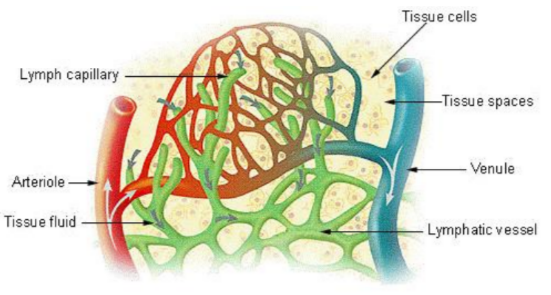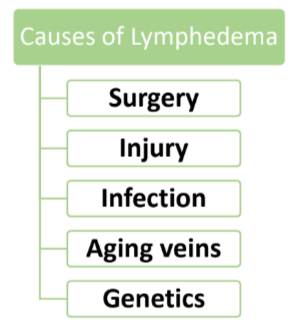Did you know that you have two circulatory systems?
It’s true. The circulatory system you know about is the one powered by your heart, pumping blood through arteries to all your tissues, and returning that blood to the heart through veins. But there’s a second circulatory system lurking in the background. The lymphatic system.
Your circulatory system circulates blood, of course. Your lymphatic system circulates lymph.
So, what is lymph?

Lymph is a clear, colorless fluid. It is very similar to blood plasma. Lymph contains all sorts of goodies, like lymphocytes, which are white blood cells that help you fight infections. Lymph also contains dissolved proteins, lipids and electrolytes.
Lymph seeps out of tissues into “interstitial spaces”, which are the spaces in between cells. Tiny lymphatic vessels collect the lymph, and transport it through a series of lymph nodes distributed throughout your body. Eventually, the lymph is returned to the blood. But at any given moment, a large part of the blood’s liquid volume is actually in the form of lymph.
Things can go wrong with the system that returns lymph fluid to the blood.
For example, surgeries or injuries can disrupt lymph nodes. Other conditions can also lead to excess lymph accumulating, such as the deterioration of veins with age or disease. When the lymphatic system is disrupted or overwhelmed with excess lymph, we can develop a chronic condition called lymphedema. Essentially, lymphedema is swelling of tissues due to excess lymph.

The swelling can cause pain, stiffness and fatigue. That’s easy to understand. But chronic lymphedema is associated with other problems as well. Problems like abnormal accumulations of fat, or fibrosis, in which the body’s connective tissues become replaced by a sort of scar tissue. Finally, lymphedema is associated with inflammation, which can cause all sorts of other problems.
Lymphedema is poorly understood, and few effective treatments exist.
In fact, the most widely accepted treatments for lymphedema are compression (tight socks or sleeves that squeeze the swollen tissues) and Manual Lymphatic Drainage (MLD), also known as lymphatic drainage massage).
Lymphatic Drainage Massage is different from other types of massage therapy.
The locations, pressures and sequences of lymphatic drainage massage are specifically targeted towards increasing flow within “congested” lymph nodes and vessels. The therapist starts with centrally located nodes and moves outwards, and finally towards the extremities. The gentle approach focuses pressure to empty lymph nodes which haven’t drained properly, creating an avenue for proper draining. Beyond the well-established benefits for relieving pain, stiffness and fatigue, this powerful technique can help control the inflammation associated with chronic lymphedema. Untreated, this inflammation can lead into a vicious cycle in which yet more fluid is drawn into already swollen tissues, which in turn increases inflammation.
A great option for managing pain and inflammation
Because lymphatic drainage massage is gentle and effective for managing pain and inflammation, it is recommended for many conditions in which pain and inflammation are primary symptoms, such as Lyme Disease, Fibromyalgia and Rheumatoid Arthritis, among others. And because a properly functioning lymphatic system is crucial for immunity (remember all those helpful lymphocytes contained in lymph?), lymphatic drainage massage is also helpful for rebuilding immunity in the aftermath of immunosuppressive events such as chemotherapy, substance abuse or any of a myriad of medical treatments that modulate immune function. Lymphatic drainage massage has been shown by many peer-reviewed clinical studies to alleviate symptoms of lymphedema.
Long story short:

